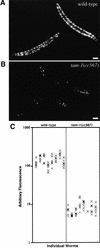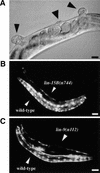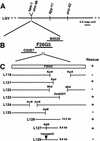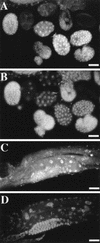The RING finger/B-box factor TAM-1 and a retinoblastoma-like protein LIN-35 modulate context-dependent gene silencing in Caenorhabditis elegans
- PMID: 10580003
- PMCID: PMC317160
- DOI: 10.1101/gad.13.22.2958
The RING finger/B-box factor TAM-1 and a retinoblastoma-like protein LIN-35 modulate context-dependent gene silencing in Caenorhabditis elegans
Abstract
Context-dependent gene silencing is used by many organisms to stably modulate gene activity for large chromosomal regions. We have used tandem array transgenes as a model substrate in a screen for Caenorhabditis elegans mutants that affect context-dependent gene silencing in somatic tissues. This screen yielded multiple alleles of a previously uncharacterized gene, designated tam-1 (for tandem-array-modifier). Loss-of-function mutations in tam-1 led to a dramatic reduction in the activity of numerous highly repeated transgenes. These effects were apparently context dependent, as nonrepetitive transgenes retained activity in a tam-1 mutant background. In addition to the dramatic alterations in transgene activity, tam-1 mutants showed modest alterations in expression of a subset of endogenous cellular genes. These effects include genetic interactions that place tam-1 into a group called the class B synMuv genes (for a Synthetic Multivulva phenotype); this family plays a negative role in the regulation of RAS pathway activity in C. elegans. Loss-of-function mutants in other members of the class-B synMuv family, including lin-35, which encodes a protein similar to the tumor suppressor Rb, exhibit a hypersilencing in somatic transgenes similar to that of tam-1 mutants. Molecular analysis reveals that tam-1 encodes a broadly expressed nuclear protein with RING finger and B-box motifs.
Figures







References
-
- Assaad F, Tucker K, Signer E. Epigenetic repeat-induced gene silencing (RIGS) in Arabidopsis. Plant Mol Biol. 1993;22:1067–1085. - PubMed
-
- Brunk B, Martin E, Adler P. Drosophila genes Posterior Sex Combs and Suppressor Two of Zeste encode proteins with homology to the murine bmi-1 oncogene. Nature. 1991;353:351–353. - PubMed
Publication types
MeSH terms
Substances
Grants and funding
LinkOut - more resources
Full Text Sources
Other Literature Sources
Molecular Biology Databases
